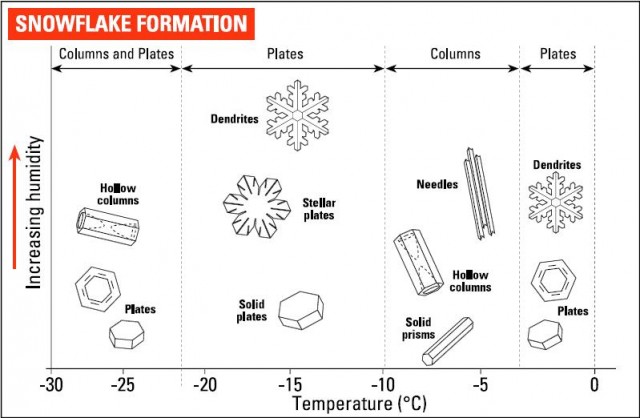How to start an ice age
The Earth's 160,000 glaciers may be culled radically during our lives, but it is still very likely that the Earth's long-term future contains more ice ages. If it does, the massive glaciers and ice sheets that it entails will start small, like those we see today once did, with snow crystals that fall and do not melt.
As we saw in Chapter 5, snowflakes form in clouds, and far more form than ever reach the ground. Often they melt within the cloud or on the way down and fall as rain.
But the one thing everyone knows about snowflakes is wrong. It is not true that every one is different. In fact they come in a few basic shapes and sizes. Some considerable effort has been put into classifying the different types – in 1951 the International Commission on Snow and Ice produced a snowflake classification, and more recently an eighty-type classification was introduced. The bare bones are that the simplest shapes are hexagonal prisms. Depending on their proportions, these can appear as long columns (like a pencil) or thin plates. Then come the “stellar” plates, which have six arms forming a star-like shape. If these arms develop branches, the crystals are known as dendrites (tree-like shapes). The bushiest and most elaborate of these are called fern like.
The shape of a snow crystal depends on both the temperature and the humidity of the air in which it formed. Even small changes in temperature can make a surprising difference to the shape of crystal formed. So thin plates and stars form at around -2°C, while at around -5°C, columns and slender needles form. When the temperature drops to around -15°C, plates and stars form again, while at temperatures down to around -30°C, plates and columns are found. Why the shapes change so much with temperature remains something of a mystery. Kenneth Libbrecht, the world's leading expert on snowflake science and chairman of the physics department at the California Institute of Technology, no less, says that nobody knows just why.
When humidity is low, the simplest plates and prisms are formed, while the more complex or extreme shapes, such as the elaborately branched dendrites and very slender needles, form when humidity is high.
